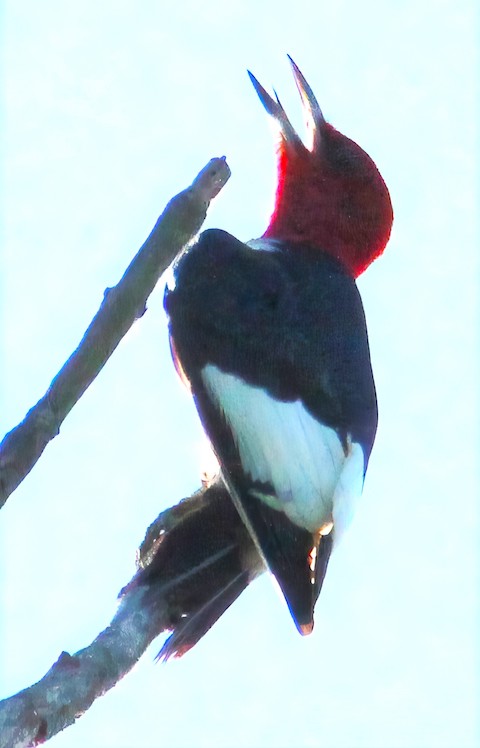I was hiking down the main trail to the Fox River observation platform in the Hoover Forest Preserve (one of my favorite outdoor activities) near Yorkville just a couple of weeks ago in early October when I heard several unfamiliar calls emanating from the crowns of some tall white oak trees about half-way from the parking lot to the river. The calls were quite harsh like a quick “brrrr” sound that sounded very “woodpecker-ish” to me. I was not able to positively identify the calls though, so I got my cell phone out and accessed my trusty Merlin app and recorded the calls I was hearing. Merlin came back immediately with an ID: Red-headed Woodpecker. I thought “Of course! That makes perfect sense!” as I scanned the trees to get a glimpse of these beautiful birds. The Red-headed Woodpeckers were quite common in Aurora when I was growing up back in the 1960’s. They were the most common woodpecker I would see in that area in my youth. As time passed however, they became less and less common. Today, for me at least, seeing a Red-headed Woodpecker has become a “red-letter” occurrence worthy of celebration!
An Increasingly Rare Beauty
Seven of the seventeen species of woodpeckers indigenous to North America inhabit the State of Illinois. The Red-headed Woodpecker joins the Downy, Hairy, Red-bellied, and Pileated Woodpeckers, along with the Northern Flicker and Yellow-bellied Sapsucker to round out this list. Of all seven of these woodpecker species native to Illinois, only the Red-headed Woodpecker and the Northern Flicker are declining in numbers. Since the mid-1960’s, Red-headed Woodpecker numbers have declined over 50 percent according to the North American Breeding Bird Survey. As of today, Partners in Flight (a consortium of organizations dedicated to the preservation of birds) estimates there is a global breeding population of only 1.8 million Red-headed Woodpeckers, leading that organization to place them on their Yellow Watch List as a species to be specially monitored to prevent further decline. While their percentage decline in population is similar, Northern Flicker global populations are estimated at about 12 million birds, over ten times the population of Red-headed Woodpeckers, keeping the Flickers off the watch list.
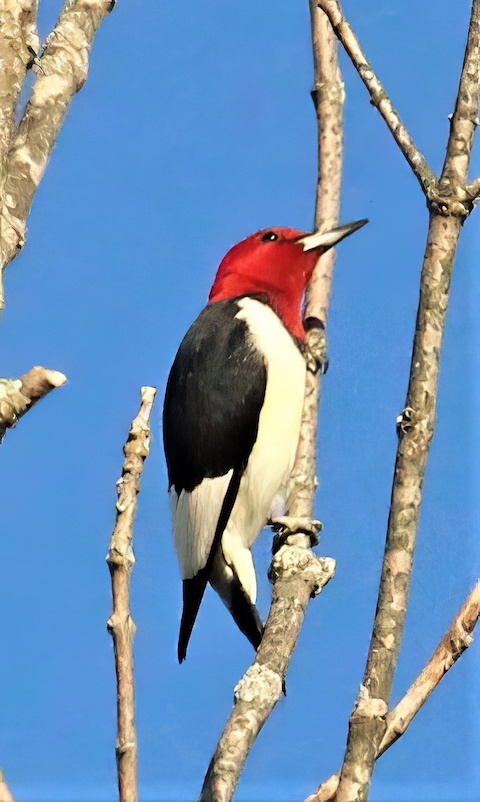
The lighting for this picture really highlights
the bird’s beautiful plumage!
Reasons for Decline
Reasons cited for the decline in numbers of Red-headed Woodpeckers include the decline of various nut-bearing trees, particularly beech and chestnut that are favored foods of the Red-headed Woodpeckers, and loss of breeding habitat in the form of dead and dying trees that were removed as part of forest management and urban beautification efforts. The Red-headed Woodpeckers prefer to nest in hollowed out sections of dead trees where they lay their eggs directly on the floor of the hollowed-out section. Both the male and female birds will help excavate the hollows in the trees. They will also use a natural hollow when available. They are one of the few woodpecker species that will use the same nesting hollow from year to year. Some authorities though, have noted that Red-headed Woodpeckers are quite nomadic and seeing them in a particular area one year is no guarantee they’ll be back the next year. Ah, the vagaries of nature!
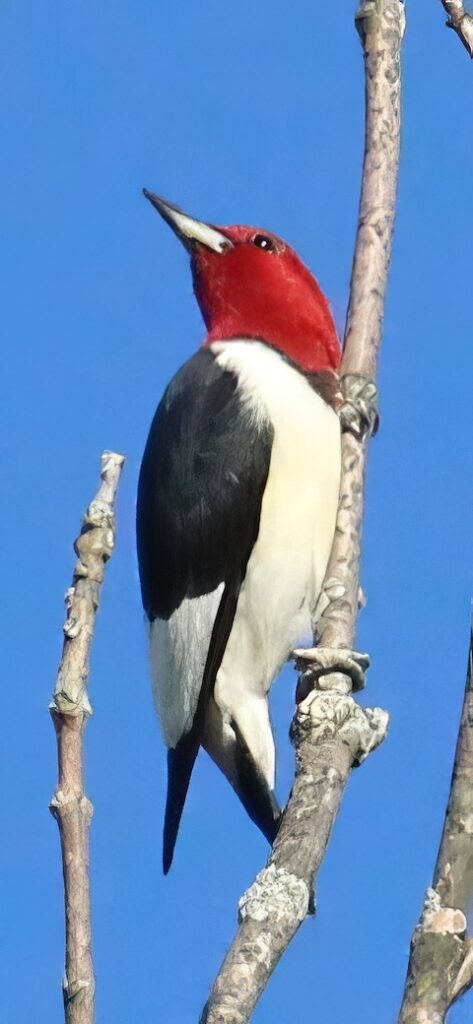
Feeding Preferences
In addition to eating nuts, during the warmer months they prefer to catch and eat flying insects on the wing. They are highly effective hunters and foragers and cache some of the food they find in hiding places under the bark of trees, and even under the shingles on the roofs of buildings, for later consumption. This year is a masting year for oak trees at the Hoover Forest Preserve and they are dropping bumper crops of acorns this autumn as a result. This may have been a helpful factor in my recent sightings of the beautiful birds in the preserve as acorns are one of the Red-headed Woodpeckers’ favorite foods.
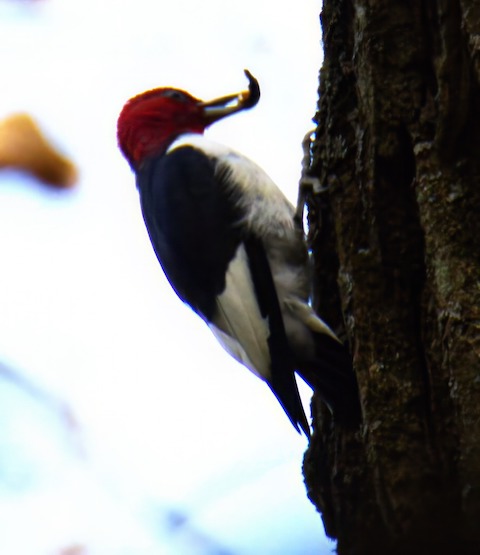
Where to Look for Them
It has been noted that Red-headed Woodpeckers prefer spending their time in the upper reaches of the trees they forage in during the Fall season. This factor makes it more difficult for an observer to spot them, but the trees’ shedding their leaves as Fall progresses should help in that regard. It has also been reported that while Red-headed Woodpeckers prefer to inhabit upland forest areas during the spring, summer, and fall, they often move to bottomland hardwood forests along rivers as winter approaches. I hope the fact that the Red-headed Woodpeckers that I have been seeing near the river in the Hoover Forest Preserve isn’t an indicator of an early winter! I’m not ready for that yet!
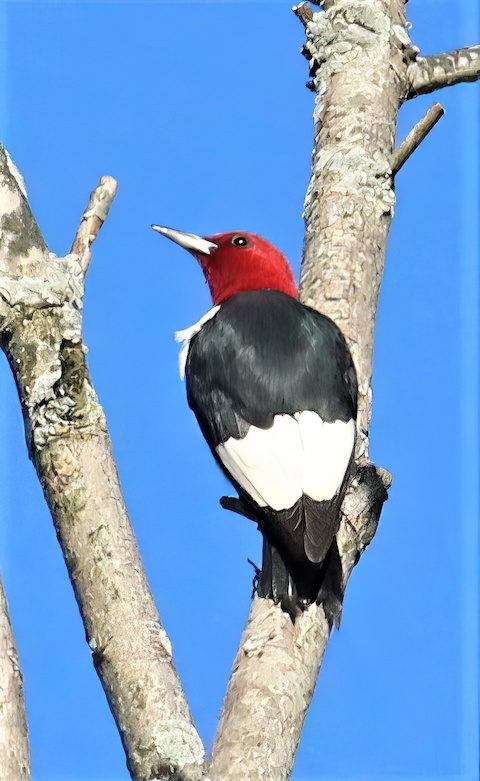
shows off in the sunlight.
Just in case if you happen to be out in a forested area along our beautiful Fox River in the next few weeks, keep your eyes and ears open to possibly catch a glimpse of a beautiful Red-headed Woodpecker. Until next month, enjoy the natural wonders our Fox River Valley provides.

